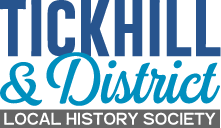

Raising money for disasters in other communities
Autumn and winter saw exceptional rainfall with resulting devastation in many areas. Homes and businesses were ruined, roads impassable and crops submerged. For some, insurance cover helped to replace damaged property. However, all affected faced months of stress and disruption. How did communities and individuals cope with disasters in the more distant past? They petitioned the monarch to issue royal mandates or briefs in the form of Letters Patent to seek financial contributions from ‘all well-disposed persons’. Because charity was seen as a Christian duty, the parish was the usual point of contact. On receipt of the royal plea, clergy would urge parishioners at Sunday services to contribute to whatever cause was specified, often for people living in places far from this area.
These requests reached their peak after the restoration of the monarchy in the second half of the 17th century. At this time both Tickhill and Wadworth parishioners donated a coin or two, if they were able, to help communities and individuals facing a range of disasters. These charitable gestures were recorded in parish registers, as the following examples show.
The Rev Edmund Berkinshaw, Vicar of Tickhill, wrote that on 30 June 1667 a total of four shillings was collected in Tickhill Parish Church towards reparation of the losses sustained as a result of a fire in the town of Loughborough, Leicestershire. The money was handed to the deputed Collector by the Vicar.
Wadworth Parish Register lists several more examples of raising money, explaining this was the result of royal mandates delivered in the King’s Letters Patent. Some funding was intended to help communities many miles away which had suffered loss from floods and fires, but help was also sought for individuals whose ships had been wrecked, for example:
- In December 1661 parishioners gave one shilling and eight pence towards the repairs and losses of the town church and inhabitants of Bridgnorth in Shropshire.
- On 2 January 1661/2 the sum of two shillings and four pence was collected for Henry Harrison, a mariner, towards his loss of £7,500 by shipwreck
- On 23 March 1661/2 parishioners donated two shillings for Thomas Welby, merchant, towards his losses of £3,145 by shipwreck.
- On 23 March 1661/2 one shilling and sixpence was raised for the inhabitants of Watchet in Somerset whose buildings were ruined by ‘the overflowing of the sea’, losses amounting to £3,000.
- On 18 May 1662 the parish raised one shilling and eight pence for John Wolrich of Cresswell in Staffordshire towards his losses of £600 and upwards caused by an accidental fire.
- On 3 May 1663 two shillings and eightpence was collected for the inhabitants of Hexham, Northumberland, where fire had caused losses to the value of £7,000.
- On 24 July 1664 three shillings and two pence was donated towards the repairs of the Parish Church of Withsham in Sussex which was burnt down by ‘thundring and lightening’ causing damage amounting to £1,879.
- On 7 August 1664 parishioners gave two shillings and ninepence to help the people of Grantham whose losses from fire amounted to £1,289/9/4.
This system of raising money was open to fraud in two ways. Unscrupulous individuals could fabricate disasters to claim recompense. Also, once money had been collected for those genuinely in need, not all of it might reach intended recipients. There is no evidence to suggest that the causes listed above supported by local people were not genuine or that their donations did not reach those who had petitioned the King.
For more information see Houston, R. R., Church briefs in England and Wales from Elizabethan times to 1828, 2015, available on website <research-repository.st-andrews.ac.uk/bitstream/handle/10023/8227/Houston_2015>